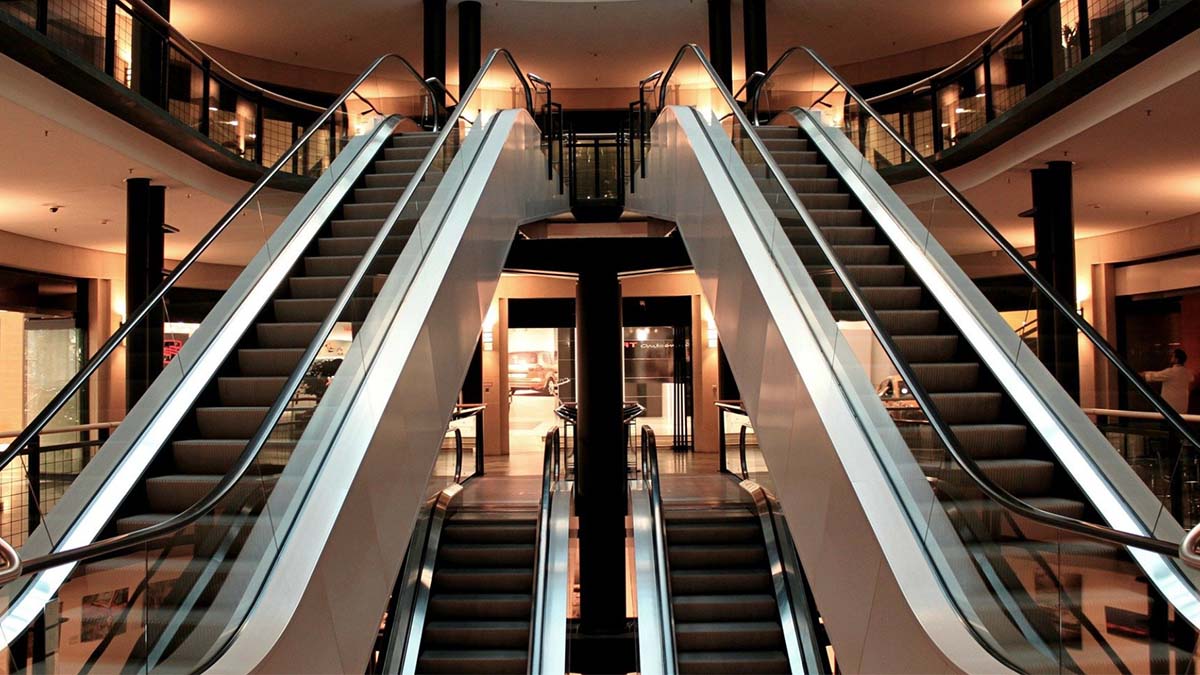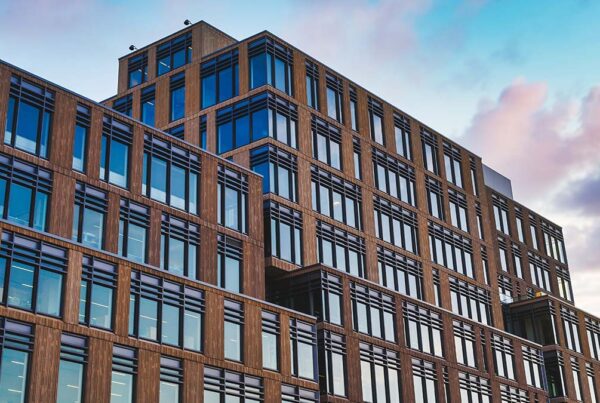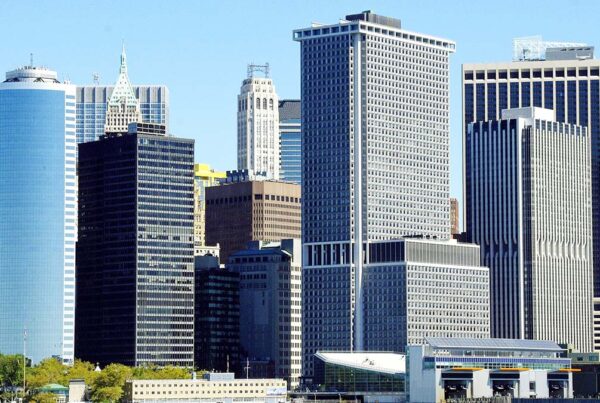
Retail real estate is used by businesses to sell products and services to consumers.
Tenants that rent retail properties include a wide variety of businesses such as:
- Banks
- Pharmacies
- Restaurants
- Service Providers (e.g. dry cleaners, nail salons, pet groomers, etc.)
- Big Box Retailers
- Grocery Stores
- And more
What are the Types of Retail Real Estate?
There are seven types of retail properties. Every kind of retail property has a unique use case, so it’s essential to understand the differences.
1. Malls
A mall is one of the most iconic types of retail real estate and is generally a large, enclosed building that houses a large number of stores under a single roof. Tenants within shopping malls typically consist of large department stores, specialty retail, apparel, a food court with fast-food options, and larger sit-down restaurants. The large department stores and sit-down restaurants typically serve as the “anchor” tenants that draw consumers into the mall.
In terms of size, malls typically start around 400,000 square feet and don’t have a cap on their size. For example, the South China Mall in Dongguan, China, has 7.1 million square feet of gross leasable space!
2. Lifestyle Centers
A lifestyle center is a shopping center or mixed-used commercial development that combines the traditional retail functions of a shopping mall with leisure amenities. Lifestyle centers can also be called “boutique malls” and are generally found in affluent suburban areas. They may not have a large national department store as an “anchor” tenant, but rather house a variety of known upscale brands.
From an investor’s perspective, lifestyle centers have one clear advantage over traditional enclosed malls because lifestyle centers don’t have enclosed common areas so you can save big on heating and cooling.
Since there aren’t enclosed common areas, storefronts typically face one another across a landscaped pedestrian walkway or a low-volume road. Lifestyle centers generally range between 150,000 square feet and 500,000 square feet, though they can go larger. The layout of the space is the defining characteristic of a lifestyle center.
3. Factory Outlets
A factory outlet, outlet store, or factory shop is a set of stores where manufacturers sell their inventory directly to consumers rather than wholesale to other stores. Historically, factory outlets were stores attached to the company’s factory or warehouse (hence the name). Today, companies prefer to group into outlet malls to attract more consumers to one location. The invention of the factory outlet store is often credited to Harold Alfond, founder of the Dexter Shoe Company.
Factory outlets often range between 50,000 square feet and 400,000 square feet, but they can certainly be larger.
4. Power Centers
A power center (also known as a big-box center) is a shopping center that usually contains three or more big-box anchor tenants along with a handful of smaller retailers. The larger anchor tenants in power centers often include businesses such as Target, Walmart, Lowes, The Home Depot, Best Buy, and Dick’s Sporting Goods. The smaller retailers in power centers usually include a mix of national or regional brands and convenience services. Another core characteristic of power centers is the inclusion of a few fast-food options and restaurants on pad sites in the parking lots.
Power centers typically have 200,000 to 600,000 square feet of gross leasable space.
5. Community Centers / Strip Malls
Community Centers (also known as Strip Malls or Strip Centers) are a group of stores arranged in a row that share a parking lot and sidewalk. Most Community Centers and Strip Malls face roads with significant traffic and are usually self-contained.
Many Community Centers or Strip Malls range between 125,000 square feet and 400,000 square feet of gross leasable space.
6. Neighborhood Centers
Neighborhood Centers are simply smaller versions of Community Centers/Strip Malls and often have a supermarket or a large drugstore as an anchor tenant.
Neighborhood Centers typically have between 30,000 and 125,000 square feet of gross leasable space.
7. Convenience Centers
Convenience Centers are effectively the smallest iteration of a Community Center/Strip Mall. They don’t have an anchor tenant and are rented to convenience-based retailers such as local groomers, dry cleaners, tattoo salons, nail salons, and other types of shops where customers are looking for a quick purchase or service.
Convenience Centers are smaller properties that often include less than 30,000 square feet of gross leasable space.
Mixed-Use Retail
Retail real estate can also be used in mixed-use properties where a single property includes multiple real estate types such as retail and office real estate. When retail is used in mixed-use property, it is usually found on the street level so that consumers can easily access the stores while other types of commercial real estate (such as offices or apartments) inhabit the elevated floors.
What Are the Different Classes of Retail Real Estate?
Retail real estate is categorized into three different classes of retail buildings, including Class A, B, and C, depending on their age and quality.
What is Class A Retail Space?
Class A retail real estate represents the newest, highest-quality retail properties on the market boasting the best amenities in prime locations.
Class A retail properties usually have higher-income tenants with low vacancy rates in excellent, high-traffic locations. As a result, Class A assets are often priced high with lower CAP rates but tend to carry less risk to investors because the tenants typically sign a long lease.
What is Class B Retail Space?
Class B retail real estate represents slightly older properties in slightly less-desirable locations than Class A retail real estate. Class B assets are frequently still excellent properties and investments, they may just require a bit more updating and not be in the #1 location.
Investors often look at Class B retail properties as “value-add opportunities” because you can renovate them and get them to be closer to Class A property.
What is Class C Retail Space?
Class C retail real estate represents buildings that are generally older, have deferred maintenance, and aren’t in a great location.
Investors often view Class C retail properties as more significant “value-add opportunities” compared to Class B retail space if the property is still in a good or growing location.
Retail Real Estate 101
Retail real estate is just one of a handful of different types of real estate. Learning about retail properties can be a lot of information to take in at first. However, the more you familiarize yourself with the definitions and evaluate opportunities, the easier it will be to remember. Here’s an overview of retail real estate properties:
- Retail real estate is used by businesses to sell products and services to consumers.
- Tenants that rent retail properties include a wide variety of businesses such as:
- Banks
- Pharmacies
- Restaurants
- Service Providers (e.g. dry cleaners, nail salons, pet groomers, etc.)
- Big Box Retailers
- Grocery Stores
- Etc.
- Investors often find retail real estate appealing because the tenants often sign long-term leases and you can diversify a retail property by bringing in different types of businesses.
- There are seven types of retail properties including:
- Malls
- Lifestyle Centers
- Factory Outlets
- Power Centers
- Community Centers / Strip Malls
- Neighborhood Centers
- Convenience Centers
- Retail real estate is categorized by three asset classes including:
- Class A Retail
- Class B Retail
- Class C Retail



